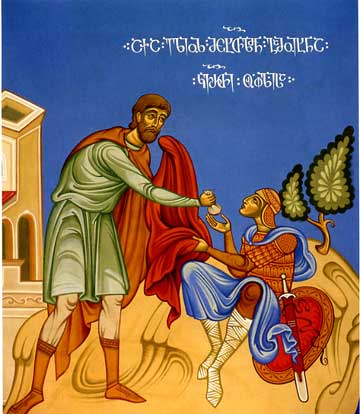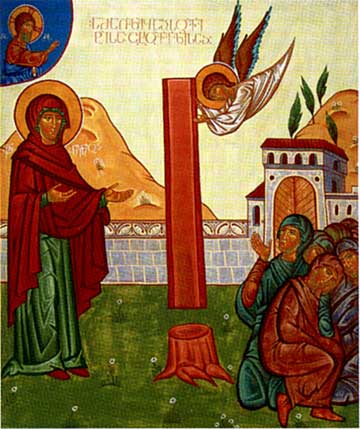
Elioz of Mtskheta acquiring the Robe of the Lord
The Feast in Honour of the Chiton (Tunic) of the Lord and the Life-Creating Pillar –
Commemorated on October 1
The Feast in Honour of the Chiton (Tunic) of the Lord and the Life-Creating Pillar – is the temple feast of the Mtskheta patriarchal cathedral in honour of the Twelve Holy Apostles, named the Sveti-Tskhoveli (which in translation means "Life-Creating Pillar"). According to the tradition of the Gruzian (Georgian) Orthodox Church, the Chiton (Greek word, in Latin "Tunic") of the Lord – the seamless garment of the Saviour (Jn. 19: 23) – came to the ancient capital city of Gruzia, Mtskheta, in the following manner.

Elioz of Mtskheta acquiring the Robe of the Lord
Eleazar (or Elioz), rabbi of the Mtskheta community of Jews, had resettled to Gruzia from Jerusalem already by the year 70 A.D. Having received news from the Jerusalem high-priest Annas about the impending execution of Christ, he hastened to Jerusalem in the company of Longinus Carsnitus [or "carsnifex", the Latin meaning "executioner"]. They became eye-witnesses to the Passion of the Lord and the casting of lots for His garment (Jn. 19: 23-24; Ps. 21 [22]: 18). At the moment when the All-Pure Body of the Lord was nailed to the Cross, the mother of Elioz, situated in Mtskheta, sensed the blows of the hammer in her heart and shuddered out of great fright. Having related to her daughter Sidonia about the crucifixion sufferings of the Saviour, guiltlessly given over unto death, the mother of Elioz then died. Elioz then acquired the Chiton from the soldier who by lots had won it, and he took it with him to Mtskheta. Sidonia, meeting her brother Elioz in tears, told him about the death of their mother and her words just before her death. Elioz confirmed the words of their mother and he showed his sister the Chiton (Tunic) of the Lord. Taking hold the Chiton, Righteous Sidonia kissed it all over, pressed it to her bosom and herewith fell down lifeless. No one, not even the emperor Aderk (2 B.C.-55 A.D.)was able to open the grasp of Sidonia nor take from her the Chiton. Righteous Sidonia (Comm. 1 October) was secretly consigned to earth by her brother Elioz in the imperial garden at Mtskheta.

The miracle of the Life-giving Pillar
The holy
Equal-to-the-Apostles Nina told about this to the Kartalin Hebrew highpriest
Aviathar – a descendent of rabbi Elioz. He came to believe in Christ, having
listened to the explanation by Saint Nina of the ancient prophecies concerning
the Messiah, and how these prophecies were fulfilled in the Lord Jesus Christ.
And the Gruzian emperor Mirian (265-342) was also converted by holy
Equal-to-the-Apostles Saint Nina, and he decided to build a Christian church on
the spot whereupon the Chiton of the Lord was situated. A massive cedar tree
had grown on the grave of Sidonia, which they sawed, and wanted to use its
truck as a foundation pillar for supporting the main cupola of the church, but
they were not able to raise it upright. Saint Nina prayed all night for Divine
help. and visions were manifest to her, in which were revealed the historical
courses of destiny of Gruzia.
At dawn an Angel of
the Lord approached the pillar and raised it in the air. The pillar, shining
with a wondrous light, was elevated and then lowered in the air, until it was
set over its base. From the stump of the cedar issued a fragrant myrh. Thus the
Angel of the Lord indicated the place, where the Chiton (Tunic) of the Lord was
concealed in the ground. This event, witnessed to by many of the inhabitants of
Mtskheta, is depicted on the icon, "Glorification of the Gruzian
Church". Afterwards at the place of the wooden church was erected the
majestic stone cathedral of Sveti-Tskhoveli. The Life-Creating Pillar, from
which occurred many healings, has at present a stone four-cornered covering and
is crowned by a light-loft, not touching the arch of the cathedral. The Pillar
is positioned in the Sveti-Tskhoveli cathedral with a model alongside of the
Church of the Sepulchre of the Lord at Jerusalem.
The Gruzian
(Georgian) Orthodox Church established the feastday on 1 October in honour of
the Chiton (Tunic) of the Lord and the Life-Creating Pillar.
© 1996-2001 by translator Fr. S. Janos.